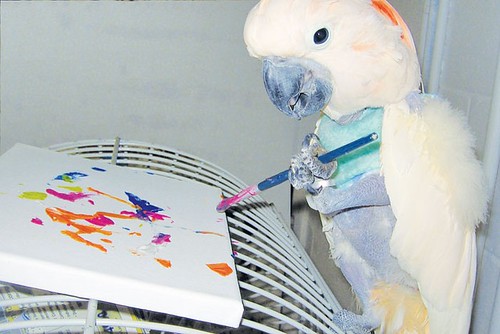 A parrot named Malachi paints a tableau at Midwest Avian Adoption and Rescue Services. (Photo courtesy of MAARS)“Art in the Hollow,” the annual art fest in beautiful Swede Hollow Park, is revving up. With the event scheduled for Saturday, June 1 (10 AM to 5 PM), painters and other artists are busy creating new works.
A parrot named Malachi paints a tableau at Midwest Avian Adoption and Rescue Services. (Photo courtesy of MAARS)“Art in the Hollow,” the annual art fest in beautiful Swede Hollow Park, is revving up. With the event scheduled for Saturday, June 1 (10 AM to 5 PM), painters and other artists are busy creating new works.
Not all the painters are human. The talented parrots who sold their paintings to last year’s art crowd are working even more diligently than the humans. Parrots paint slowly, you see. You’d paint slowly, too, if you had to grip your pointy little brush with your toes or beak.
The clever birds are East Siders, permanent residents of the “Landing,” a special-care sanctuary run by Midwest Avian Adoption and Rescue Services (MAARS) for those parrots who have been too traumatized to be adoptable.
“When we first began painting with the birds,” says a MAARS brochure, “we chose the paint colors for them. But after a few sessions they caught on to dipping the brush into the paint on the pallet and we let them choose the colors they wanted. The birds were very excited, seeing the colors come to life on paper, and while there may not be a budding Picasso among the MAARS flock, painting provides a new and fun challenge for some birds living in captivity.”
I disagree with the part about no “budding Picasso.” The nice green-and-purple print I purchased in 2012, created by a gifted parrot named Benecio, is as abstract as any Picasso masterpiece. I didn’t ask, “What does it mean?” An artsy friend once informed me that abstract works don’t have to “mean” anything. “You can give them any meaning you want,” she said archly.
Just as Picasso had his famous “blue period,” I think Benecio was in the midst of a green-and-purple period last summer, perhaps longing for a tropical garden with purple blooms. Since I don’t like smart-alecky replies, I’ll never ask him.
Whoever first decided to cage a bird was not thinking of the bird’s well-being. What could be more absurd than to take away the joy of flight from the very beings who are designed to soar? MAARS operations director Jill Gannon stated that when MAARS was founded in 1999, the organization was considered “radical” among bird fanciers because it allowed its birds to be “flighted,” to have unclipped flight feathers. Nowadays, she said, more shelters are letting their birds be flighted.
Our species robs captive birds of more than flight; it robs them of all they were meant to enjoy. Parrots are intelligent, sensitive animals who, in their natural environment, have a complex social structure with strong family bonds. They spend their days hunting for food, socializing, playing, free-flying, and teaching survival skills to their young.
Though guilty of no felony, many captive parrots serve life sentences behind bars and in solitary confinement, with no time out for exercising or fun. Parrots may live for decades, a long time to be imprisoned. Worse yet, some are victims of neglect or abuse from thoughtless owners who get bored with the birds. Maltreatment can cause the captives to indulge in neurotic behavior such as biting, feather-plucking, self-mutilation, or excessive screaming. Though they receive tender, individualized care from the Landing staff, treatment may take years. Gannon described a resident named Philippe.
“Philippe came to the shelter ten years ago a nervous, scared bird who did not often come out of his cage,” she stated. But he gradually learned to trust his keepers, eventually becoming so confident that he dared to reveal a silly streak. One of the painting parrots, Philippe refuses to use any paintbrushes handed to him by the staff; he insists upon choosing his own brushes. Maybe he’s afraid of germs.
Not all the Landing parrots are interested in painting. Some prefer other activities, such as games. “Fetch” is a favorite, but the parrots don’t do the fetching. No, they expect their doting humans to retrieve the items! Do the birds chuckle wickedly to themselves and wink at each other as they watch the keepers fetch?
The cost of maintaining each of the 90 parrots who call The Landing home is about two dollars per day. And life-enriching items such as toys and swings and painting supplies require additional funds. Anyone who would like to help financially may check out the MAARS website at www.maars.org. Contributions are tax-deductible.
Those who wish to help, but can’t afford a monetary contribution in these difficult economic times, might consider becoming Landing volunteers. They may even wish to be shift managers, responsible for coordinating the feeding, medicating, cage-cleaning, and other tasks during a four- to six-hour shift. The managers also make sure each bird gets an hour out of its cage during the shift.
MAARS executive director Galiena Cimperman has high praise for her volunteers, who “not only dedicate their time and energy to the well-being of the MAARS flock, but who also uphold MAARS values, which include providing the highest quality of life and doing whatever they can to discourage the practice of keeping parrots as pets.”
For general art-fest information, check out the Art in the Hollow website at www.artinthehollow.org.